 |  |  | |
An up close and personal interview with U.S. Army Veteran and Togetherweserved.com Member:
SP 6 Gary L. L McJimsey U.S. Army (1966-1969)
PLEASE DESCRIBE WHO OR WHAT INFLUENCED YOUR DECISION TO JOIN THE ARMY?
I did not enlist until I received my Draft Notice in late 1965. I did the Physical Exam gig and passed and received my Orders for Reporting in Oakland, CA for BCT at Fort Ord. I decided to enlist in lieu of the Draft in an attempt to avoid the  infantry and Vietnam. I enlisted in Berkeley, California, where I was living and working, and was hoping for any clerical and typing position I would qualify for in the Army. After completing BCT, I was politely informed that there were no training classes open at that time. I am still not sure that I was told the truth. So, my plan to avoid the infantry and Vietnam did not work entirely and I eventually ended up in both the infantry indirectly by way of the Army Medical Corps and in Vietnam. infantry and Vietnam. I enlisted in Berkeley, California, where I was living and working, and was hoping for any clerical and typing position I would qualify for in the Army. After completing BCT, I was politely informed that there were no training classes open at that time. I am still not sure that I was told the truth. So, my plan to avoid the infantry and Vietnam did not work entirely and I eventually ended up in both the infantry indirectly by way of the Army Medical Corps and in Vietnam.
My Vietnam unit assignment was to the First Infantry Division in Feb 1968; initially with 1st Battalion 28th Infantry Regiment and then to the 1st Medical Battalion.
No hard feelings President Johnson as I enjoyed my medical training and working in the Army Medical Corps as a 91C20 Clinical Specialist.
WHETHER YOU WERE IN THE SERVICE FOR SEVERAL YEARS OR AS A CAREER, PLEASE DESCRIBE THE DIRECTION OR PATH YOU TOOK.
 1) February 1966 BCT Fort Ord, Private 1) February 1966 BCT Fort Ord, Private
2) April 1966 Leadership Preparation Course, Fort Sam Houston, E2
3) April 1966 AIT Basic Combat Medical Training, Fort Sam Houston, E2 - E3
4) August 1966 Formal Training, 91C20 Clinical Specialist Course, William Beaumont Army Hospital, El Paso, E3 - SP4
5) July 1967 Fort Ord SP 6 Army Hospital, Orthopedic Ward, 91C20 Clinical Specialist, SP4 - SP5
6) February 1968 Vietnam, 1st Infantry Division, Clinical Specialist, SP5 - SP6; assigned to 1st Battalion, 28th Infantry Regiment, Quan Loi, RVN and then August 1968 to February 1969, A Company 1st Medical Battalion, Di An, RVN.
With the 1st/28th I worked in the field with a battalion doctor and other Clinical and Medical Specialist in support to the battalion for overall medical care and combat causalities while in the field. With the 1st Medical Battalion in Di An I worked in the Base Aid Station/Emergency Room; daily sick-call, medical emergencies, combat causalities, medical needs of Vietnamese civilians who worked on the base, and an occasional Viet Cong prisoner.
IF YOU PARTICIPATED IN COMBAT, PEACEKEEPING OR HUMANITARIAN OPERATIONS, PLEASE DESCRIBE THOSE WHICH WERE THE MOST SIGNIFICANT TO YOU AND, IF LIFE-CHANGING, IN WHAT WAY.
I served in the Vietnam War with the 1st Infantry Division, from Feb 1968 until Feb 1969. I was in the Army Medical Corps as a Clinical Specialist and was assigned to two different units of the Division working with medical doctors and other non-officer medical personnel.
The first five months  I was in the field pulling combat duty with 1st Battalion, 28th Infantry Regiment working with a battalion doctor along with other Clinical & Medical Specialists. This is the assignment where I earned my CMB and was awarded the Army Commendation Medal for Valor on March 29, 1968. I was in the field pulling combat duty with 1st Battalion, 28th Infantry Regiment working with a battalion doctor along with other Clinical & Medical Specialists. This is the assignment where I earned my CMB and was awarded the Army Commendation Medal for Valor on March 29, 1968.
Photo is me suturing a lacerated hand on one of our infantry riflemen, Tom Goodyear, when the Battalion was situated at a Night Defensive position or NDP near Song Be Village during March 1968. The soldier watching is Roger Clark, either a 91B Medical Specialist or a 91C Clinical Specialist.
The balance of my Vietnam tour I was assigned to A Company, 1st Medical Battalion, First Infantry Division, Di An, RVN. There I worked in the Base Aid Station & Emergency Room. A second Army Commendation Medal was award to me during this time for Meritorious Service.
OF ALL YOUR DUTY STATIONS OR ASSIGNMENTS, WHICH ONE DO YOU HAVE FONDEST MEMORIES OF AND WHY? WHICH ONE WAS YOUR LEAST FAVORITE?
Naturally I think BCT at Fort Ord is the least favorite. I am certain the training was very beneficial but I am not real convinced the mythology was the best.
Despite the danger, my time in Vietnam is cherished as I worked with many medical doctors in a variety of 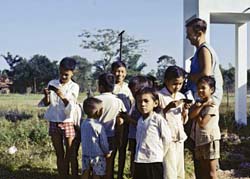 situations; some not so pleasant such as attending to a wounded soldier or losing a soldier's life. Medical Civic Action Program or MEDCAP operations were a delight wherein we helped the local South Vietnamese with their medical and dental necessities; especially for the children. The MEDCAPs might have been more PR than anything else but they made me feel like I was doing something useful with my training. situations; some not so pleasant such as attending to a wounded soldier or losing a soldier's life. Medical Civic Action Program or MEDCAP operations were a delight wherein we helped the local South Vietnamese with their medical and dental necessities; especially for the children. The MEDCAPs might have been more PR than anything else but they made me feel like I was doing something useful with my training.
Photo is Capt. Yeamans, DDS with the 1st Medical Battalion at Di An. He loved children and liked to take the kids photo with a Polaroid camera then give the photo to the children. Their faces would light up and perhaps this was the first time they saw a photo of themselves. A great way to win their hearts and break the ice. This MEDCAP was at the Lai Thieu village north of Saigon.
FROM YOUR ENTIRE SERVICE, INCLUDING COMBAT, DESCRIBE THE PERSONAL MEMORIES WHICH HAVE IMPACTED YOU MOST?
The first memorable event was in March 1968, just a few weeks after my arrival in Vietnam. I was assigned to 1st Battalion, 28th Infantry Regiment headquartered out of the Quan Loi Base. I was a Clinical Specialist and worked with one of the battalion doctors along with other Clinical/Medical Specialist.
The Battalion was situated at an NDP near the village of Song Be for about 3 to 4 week period, providing light infantry support to an artillery unit assigned to that NDP.
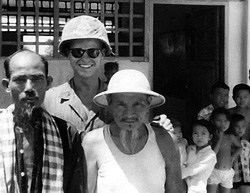 Most days were spent at the NDP and occasionally part of the battalion, including the doctor and some of his team, went on one and two day sweeps. At other times the medical team conducted one day MEDCAP operations to nearby villages. Most days were spent at the NDP and occasionally part of the battalion, including the doctor and some of his team, went on one and two day sweeps. At other times the medical team conducted one day MEDCAP operations to nearby villages.
On March 29, 1968, during one of the lazy days spent at the NDP, the battalion came under an intense mortar attack from two different VC positions across a ravine from our camp. While running from the medic's tent toward the call for help, a mortar hit the hard-as-rock ground about 25 feet in front of me. I had no idea the mortar was coming or what occurred until after it exploded. There was hardly any indentation in the ground which showed how hard the ground was. I was about 50 to 60 feet from our medic's tent and another Clinical Specialist was behind me about 20 to 30 feet; between myself and the medic's tent, when the mortar hit. That medic got hit with two small pieces of shrapnel or dirt/gravel and I was not touched. There were several soldiers nearby that were ducked down behind their sandbags and saw what had happened. They could not believe that I was still standing and not hit. I could not believe it after they told me what had just happened.
When the battalion Chaplain returned from a trip into a local village of Song Be he counted the holes going into the medic's tent from the direction of the explored mortar; he counted 100+ holes. I do believe in Devine Providence and still believe that God watches over His flock.
The second memorable event was while assigned to the A Company, 1st Medical Battalion the Di An Base. I worked the Aid Station and Emergency Room from about August 1968 until mid-February 1969.  The Battalion CO, Maj. Wilker, was an OB GYN doctor who had a practice with his father back home. He and I delivered twins of a South Vietnamese woman who worked part-time in the Ward Section of our Aid Station. This occurred just a few days before my tour ended in Feb 1969. The Battalion CO, Maj. Wilker, was an OB GYN doctor who had a practice with his father back home. He and I delivered twins of a South Vietnamese woman who worked part-time in the Ward Section of our Aid Station. This occurred just a few days before my tour ended in Feb 1969.
Photo was taken about half hour after the delivery. I am on the left and SP4 Charles Looney is on the right who helped in cleaning up the new born infants.
This was a very rewarding day that made my tour of duty with the "Big Red One" a worthy cause. We lost soldiers and civilian locales at the Aid Station but on this day we added new life. It could not get any better than that.
WHAT ACHIEVEMENT(S) ARE YOU MOST PROUD OF FROM YOUR MILITARY CAREER? IF YOU RECEIVED ANY MEDALS FOR VALOR OR OTHER SIGNIFICANT AWARDS, PLEASE DESCRIBE HOW THESE WERE EARNED.
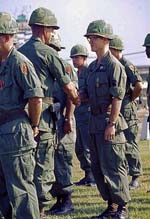 The Army Commendation Medal with 'V' Device was awarded for performing my duties on March 29, 1968, at our NDP in the area of Song Be when we came under an early afternoon mortar attack. The battalion lost one soldier and sustained several wounded on this date. A sad moment in the life of a light weapons infantry unit in Vietnam. The medal was granted to me for trying to save the life of the wounded soldier that died and for helping others during the mortar attack. The medal was presented a few months later in Di An at the Division Support Command HQ. The Army Commendation Medal with 'V' Device was awarded for performing my duties on March 29, 1968, at our NDP in the area of Song Be when we came under an early afternoon mortar attack. The battalion lost one soldier and sustained several wounded on this date. A sad moment in the life of a light weapons infantry unit in Vietnam. The medal was granted to me for trying to save the life of the wounded soldier that died and for helping others during the mortar attack. The medal was presented a few months later in Di An at the Division Support Command HQ.
OF ALL THE MEDALS, AWARDS, QUALIFICATION BADGES OR DEVICES YOU RECEIVED, PLEASE DESCRIBE THE ONE(S) MOST MEANINGFUL TO YOU AND WHY?
The Army Commendation Medal for Meritorious Service and the Good Conduct Medal are the two most meaningful to me for my service in the Army. I knew that I was not going to be a career soldier as I had other plans for the future.  These two medals remind me that performing the assigned duties to the best of my abilities, be it in the military or civilian work, are rewarded. These are common enough medals for many soldiers, especially career soldiers, and can be achieved by many. For me and for the short time spent in the military they mean more than being promoted to Spec 6 during this short period of my life. These two medals remind me that performing the assigned duties to the best of my abilities, be it in the military or civilian work, are rewarded. These are common enough medals for many soldiers, especially career soldiers, and can be achieved by many. For me and for the short time spent in the military they mean more than being promoted to Spec 6 during this short period of my life.
I have great respect for all our military service personnel who have and are now guarding our Nation daily, around the world.
WHICH INDIVIDUAL(S) FROM YOUR TIME IN THE MILITARY STAND OUT AS HAVING THE MOST POSITIVE IMPACT ON YOU AND WHY?
That dreaded Drill Sergeant in Basic Training. Wish I could remember his name. He had already finished two full tours with the infantry in combat in Vietnam. At the time of my Basic Training, early 1966, he was a Staff Sergeant then early he has been a Sgt. 1st Class. 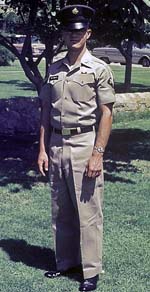 Following his second VN tour he left the military for a few months and then came back in and lost one grade at the time of reenlisting. He had tons of military experience and lots of combat advice which he was able to share a bit with me during the week following BCT; as I was held over one week waiting for my AIT orders to Fort Sam. Apart from always keeping the weapon clean and ready he instructed me in the fine art of making-love-to-the-ground; one of the best methods for staying alive in combat and one that I put to practice. Following his second VN tour he left the military for a few months and then came back in and lost one grade at the time of reenlisting. He had tons of military experience and lots of combat advice which he was able to share a bit with me during the week following BCT; as I was held over one week waiting for my AIT orders to Fort Sam. Apart from always keeping the weapon clean and ready he instructed me in the fine art of making-love-to-the-ground; one of the best methods for staying alive in combat and one that I put to practice.
Most likely all of us that served in the US military had a 'best-friend' during part or all of our time in the military. Mine was John Hoff from Northern California. We both started our army service about the same time and assigned to Fort Ord, California for our Basic Training. John might have been two or three weeks behind me. I first met John at Fort Sam Houston at the Army Medical Training Center in early May 1966. We both were assigned to the Basic Combat Medical Training at Fort Sam. However, before we started the actual medical training we were both assigned to the two week Leadership Preparation  Course at the Medical Training Center - that is where we meet and became friends. John and myself were then assigned to different training companies for the Basic Combat Medical Training but continued to see each other from time to time. Course at the Medical Training Center - that is where we meet and became friends. John and myself were then assigned to different training companies for the Basic Combat Medical Training but continued to see each other from time to time.
Upon completion of our AIT we were both assigned to a Formal School for advanced medical training; the 91C20 Clinical Specialist Course which was a coveted course, especially for the career enlisted medical specialist. John and I were both assigned to the same school at the William Beaumont Army General Hospital in El Paso, Texas. The course started in September 1966 and graduation was at the end of June 1967, when we both were promoted to SP5. We received orders for our first assignment to Fort Ord Army Hospital, Fort Ord, California.
To our amazement we meet up again, as both of us were assigned to the two orthopedic wards at the hospital. I was married and lived off base with my wife but naturally continued to see John.  John was married sometime in late 1967, and we both soon received our orders for Vietnam; just a couple of weeks apart on our departure date; I went first and figured I might not see John again. South Vietnam is a small country but yet very large when it comes to the number of military units stationed there. John was married sometime in late 1967, and we both soon received our orders for Vietnam; just a couple of weeks apart on our departure date; I went first and figured I might not see John again. South Vietnam is a small country but yet very large when it comes to the number of military units stationed there.
I arrived in Vietnam mid February 1968, and was eventually assigned to 1st Battalion, 28th Infantry Regiment, 1st Infantry Division - in the field. To my amazement and downright astonishment John arrived about 2-3 weeks later to the very same unit. We worked together in the field under the command of a battalion doctor until I was transferred to the 1st Medical Battalion at Di An. I have not yet seen John since July 1968, but was able to make contact with him about three years ago with help from members at TWS. John lives about 2 1/2 hours drive north of me and we will get together when he retires as a registered nurse.
Taken on May 10, 1968, near Thu Duc, RVN this photo is Capt. Gary Haddock, MD and Spec 5 John Hoff (without a shirt).
Some things are just meant to be - this was one of those things.
CAN YOU RECOUNT A PARTICULAR INCIDENT FROM YOUR SERVICE WHICH MAY OR MAY NOT HAVE BEEN FUNNY AT THE TIME, BUT STILL MAKES YOU LAUGH?
 During a brief fire fight while with the 1st/28th, Black Lions, the AK-47s and M-16s stopped suddenly. Being in the Medical Corp and assigned to the battalion doctor, I was situated in mid-column of the battalion, along with the doctor and others medics of his team. We were just a short distance behind the battalion commander Lt. Col. Leland C. Rew, Jr, and could hear him talking on the horn but could not make out what the conversation was. Word was passed down to sit-tight. So, taking the advice of my BCT Drill Sergeant, I rolled over into a shallow depression in the jungle floor to wait out the situation and took a short cat-nap. This is only humorous to me when I think back on it as I could have been left behind and that shallow depression in the ground could have become my grave. During a brief fire fight while with the 1st/28th, Black Lions, the AK-47s and M-16s stopped suddenly. Being in the Medical Corp and assigned to the battalion doctor, I was situated in mid-column of the battalion, along with the doctor and others medics of his team. We were just a short distance behind the battalion commander Lt. Col. Leland C. Rew, Jr, and could hear him talking on the horn but could not make out what the conversation was. Word was passed down to sit-tight. So, taking the advice of my BCT Drill Sergeant, I rolled over into a shallow depression in the jungle floor to wait out the situation and took a short cat-nap. This is only humorous to me when I think back on it as I could have been left behind and that shallow depression in the ground could have become my grave.
In the center of this photo taken on May 10, 1968 is Lt. Col. Leland Chadwick Rew, Jr. (Ret) inspecting the weapons captured that day by one of the battalion's units during the daily patrol sweep. He was a West Point grad of 1953 and retired from the Army in 1974. Deceased in January 2003.
WHAT PROFESSION DID YOU FOLLOW AFTER YOUR MILITARY SERVICE AND WHAT ARE YOU DOING NOW? IF YOU ARE CURRENTLY SERVING, WHAT IS YOUR PRESENT OCCUPATIONAL SPECIALTY?
I was working at the Fort Ord Army Hospital when I received orders for Vietnam, leaving behind my wife in Monterey so she could continue going to Monterey Peninsula College (MPC).
Following my separation from the Army in February 1969, I returned to Monterey, CA and returned to banking for a few months until the Fall Semester of 1969 started at MPC when I returned to college. After obtaining my BS in Business Administration from California State University - Fresno, I once again returned to banking until I retired from that occupation.
WHAT MILITARY ASSOCIATIONS ARE YOU A MEMBER OF, IF ANY? WHAT SPECIFIC BENEFITS DO YOU DERIVE FROM YOUR MEMBERSHIPS?
 I am Life Member of The 28th Infantry Regiment Association - Black Lions, and The Society of The First Infantry Division. I am Life Member of The 28th Infantry Regiment Association - Black Lions, and The Society of The First Infantry Division.
I receive quarterly newsletters and magazines from both associations that keep me up on what these units are doing. I especially enjoy reading the history stories in the Bridgehead Sentinel from the Society of The First Infantry Division. I have learned a great deal regarding combat operations and battles of The First Infantry Division in Vietnam by reading the Bridgehead.
Additionally, I am a Life Member of the Vietnam Veterans of America, the Association of The United States Army, and The Army Historical Foundation including membership in the National Museum of The United States Army.
The On Point magazine from the Army Historical Foundation has been of immense value to me in preparing memorial profiles on ATWS and it has lead me to some very good books for reading material; some of which has helped me in completing a few ATWS Vietnam Fallen Profiles.
Life Member of The Dustoff Association.
Life Member of Army Together We Served.
IN WHAT WAYS HAS SERVING IN THE MILITARY INFLUENCED THE WAY YOU HAVE APPROACHED YOUR LIFE AND YOUR CAREER?
 There are rough patches in life that need to be dealt with just as in combat when you are uncertain of the outcome. Keeping a level head, thinking things through, considering the options, and talk it over with a friend if possible has always proven to be the better path for me, rather than just charging ahead without knowing what lies behind the bushes. There are rough patches in life that need to be dealt with just as in combat when you are uncertain of the outcome. Keeping a level head, thinking things through, considering the options, and talk it over with a friend if possible has always proven to be the better path for me, rather than just charging ahead without knowing what lies behind the bushes.
BASED ON YOUR OWN EXPERIENCES, WHAT ADVICE WOULD YOU GIVE TO THOSE WHO HAVE RECENTLY JOINED THE ARMY?
Stand tall and do not be afraid of the future or the unknown. Do your assignments better than what you think you can do. Plan, study and always move forward in your military and civilian life. Along your life's journey treat every individual equally and with kindness.
IN WHAT WAYS HAS TOGETHERWESERVED.COM HELPED YOU REMEMBER YOUR MILITARY SERVICE AND THE FRIENDS YOU SERVED WITH.
When I registered with ATWS in 2009, I figured the web site to be just another Military.com type of site. That proved to be poor thinking on my part. Shortly after joining and having some contact with other members in helping me to get my units, ribbons and other details 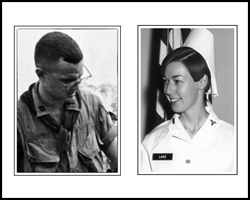 posted to my profile, I was invited to be part of the Volunteer Profile Assistants (VPA) in helping other new members with questions and getting their profiles squared away. I still provide some volunteer help to ATWS doing a bit of this and a bit of that but mostly trying to help in getting our Army Vietnam Fallen Profiles completed. More time is needed as there is a lot to do and a lot that can be done for the TWS site. posted to my profile, I was invited to be part of the Volunteer Profile Assistants (VPA) in helping other new members with questions and getting their profiles squared away. I still provide some volunteer help to ATWS doing a bit of this and a bit of that but mostly trying to help in getting our Army Vietnam Fallen Profiles completed. More time is needed as there is a lot to do and a lot that can be done for the TWS site.
The real blessing for me is making contact with a family member of a Vietnam Fallen. They are so appreciative of what TWS does in creating a Remembrance Profile for their fallen family member. It is a great joy to me when a family member is able to provide personal information and photos of their lost one that can be used on a VN Fallen Profile. Working on the Vietnam Fallen Remembrance Project and creating other Assisted/Memorial profiles for other soldiers of WWII, Korea and Vietnam does have a profound and lasting effect on me.
I do not think I will forget some of these individuals even though I never met them; such as 1st Lt. Sharon Ann Lane, Army Nurse Corps, KIA June 8, 1969. Then there is Capt. Howard Martin Gerstel, MD, Army Medical Corps, KIA October 4, 1967. In some ways they are 'ghosts' of the past and they might even remind me of someone else in my life. Ghosts or not, which I do not believe in, these lost men and women of wars past, once had a life, a family, friends, dreams and plans for their future, until one day...
In Memory of Howard Martin Gerstel and Sharon Ann Lane, and thousands like them who died in combat serving our great nation.
|


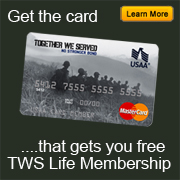

Read Other Interviews in the TWS Voices Archive | Share this Voices Edition on:


  |
|
TWS VOICES
Voices are the personal stories of men and women who served in the US Military and convey how serving their Country has made a positive impact on their lives. If you would like to participate in a future edition of Voices, or know someone who might be interested, please contact TWS Voices HERE.
This edition of Army Voices was supported by:
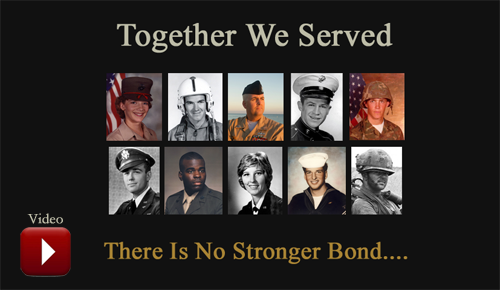
Army.Togetherweserved.com
For current and former serving Members of the US Army, US Army Reserve and US Army National Guard, TogetherWeServed.com is a unique, feature rich resource helping Soldiers re-connect with lost Brothers, share memories and tell their Army story.
To join Army.Togetherweserved.com, please click HERE.
| |